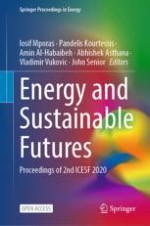22.1 Introduction
22.2 Theory and Methodologies

22.3 Results and Discussion
-
Size: Annual generation of the system should be less than 2,500,000 kWh.
-
Availability: There should be no days with more than 1 h no generation situation.
-
Renewability: Utilization of renewable sources should be more than 20% of overall generation.

